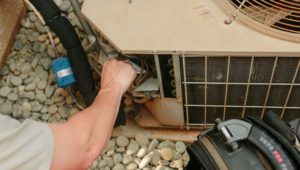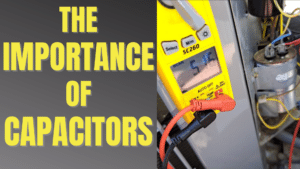Understanding How a Gas Furnace Works and the Sequence of Operation
Hey guys, how are you doing? Today I’m going to describe for you the sequence of events that needs to happen for your furnace to start blowing warm air into your house. We’ll start at the thermostat and go all the way to the blower turning on, forcing air into the rooms of your home. Furnace troubleshooting is the topic coming up today on Fox Family Heating and Air.
Furnace Troubleshooting Safety
First, I want to give fair warning to anyone watching this that isn’t already an experienced technician in the HVAC industry. This furnace troubleshooting video is for educational purposes only. Fox Family Heating and Air does not recommend anyone other than a professional start opening up the furnace to try to diagnose the failure going on with your system.
There are high and low voltages that can shock a person. There are also lots of moving parts that can damage body parts—namely, hands and fingers. The furnace also produces hot surfaces within the furnace compartments and around the housing, potentially causing severe burns. An actual flame produced by the ignition and startup of a gas furnace can cause severe burns and damage to a person or property.
When your house reaches a point where the heat needs to come on to keep you comfortable, a series of components work in a specific order to produce that heat.
The Thermostat
The thermostat is the first part of the sequence that engages, making the furnace work. There’s 24-volt power at the R terminal of the stat already. Within the workings of the thermostat, 24 volts closes a switch at the W terminal. That signal is sent to the control board back at the furnace.
The Furnace Control Board
The control board is a printed circuit board with various switches, resistors, and terminals that act as the quarterback of the heating system. It calls the plays as they need to happen.
Low Voltage Wires
The control board has a terminal block with screws on it, with a set of thin low voltage wires coming from the thermostat. Typically, the colors of these wires are red, yellow, white, green, and blue. The wires are going to R (red), Y (cooling), white (heat), green (blower motor), and blue (common).
Note: the wire colors don’t matter here. They’re still copper on the inside of the sheathing. So if we use a brown wire for R at the control board, brown needs to be hooked up to R at the thermostat.
The Inducer Motor
Once the control board receives the thermostat signal to turn the heat on, it tells the inducer motor to come on. The inducer motor is a major component that removes the carbon monoxide from the flame of the gas furnace. It draws the spent gasses into the metal or PVC flue pipe, which transfers those fumes from the furnace to the atmosphere through the roofline. You may have seen the metal pipe sticking out of the roof of your house in the winter, exhausting steam into the air. That’s the exhaust we’re talking about here.
The Pressure Switch
This safety device proves that the inducer motor is on and doing its job properly. If it’s not, the sequence shuts down and retries again. This pressure switch is actually measuring the suction the inducer motor is producing and sends a signal back to the board, letting it know that startup is working so far.
Roll Out and High Limit and Pressure Switches
Meanwhile, other low voltage safety switches are sending a signal of all-clear back to the board. There are a couple of “roll-out” switches and a high-temperature limit switch that must confirm to the control board all is well there, too. The wires leading to the roll-out, high limit, and pressure switches are usually all wired in the same series circuit with each other as a safety control. If any of these safety switches sense anything wrong with the heating system’s startup, the sequence stops, and retries.
The Ignition Sequence
Next, three components engage in lighting the flame and proving that it is lit. When the pressure switches and other safeties tell the control board all is well, the board starts the ignition sequence. First, the board sends a signal to the ignitor. This could be a hot surface ignitor that glows orange or a spark ignitor, which produces an arc between two metal forks lasting for several seconds. (My blog post and video discussing why hot surface ignitors fail might be of use for you, too.)
Whether the ignitor glows or sparks or not, the next component, 24 volts, is sent to the gas valve, which opens the diaphragm inside of it. It opens, allowing natural or propane gas to flow on to through the metal burner assembly.
The Heat Exchanger
The gas now flowing through multiple orifices in the burner assembly reaches the ignitor, causing a flame to ignite and burn in a controlled fashion straight into the firebox or heat exchanger. For the purposes of this post, we’ll call it the heat exchanger.
Crossover channels within the burner assembly allow the gas to flow from the first burner to the last one, where the flame pours over a thin metal safety rod called the flame sensor. The flame meeting the rod creates a millivolt DC signal to the control board that allows the gas valve to remain open. No flame being sensed means gas is flowing uncontrolled throughout the furnace cabinet, which is not good.
At this point, we have power, a good thermostat, a functioning inducer motor, ignition, flame, and flame sensor to verify it.
A delay now occurs to allow the heat exchanger to warm up so cold air isn’t sent through the ducts and into the air. The heat exchanger is a hollow metal box with individual chambers. The flame pours into each chamber, warming the metal to an extreme temperature.
Once hot enough, the air that flows over and around the metal box warms quickly from room temperature to about 100 to 140 degrees. The temperature is set by the manufacturer and must be closely adhered to. This will keep the system operating safely and to proper specs.
The Blower Startup
After this delay completes, the blower starts up, sending forced room temperature air over the correct speed of the metal heat exchanger. If the air is sent over too fast, the air entering the room won’t be warm enough. Too slow of air or not enough air and the system gets too hot. Too hot means the high-temperature limit we discussed earlier will open, telling the control board something’s not right. So, this blower motor has to be dialed in just right.
Furnace Troubleshooting Tips
Here are some things that can happen when the furnace isn’t starting up correctly. The following troubleshooting tips are not all-inclusive and are not to be taken as scripture that what is going with the furnace you’re working on is the problem. These are general problems only.
No power to the board – If the unit is plugged in correctly and the breaker at the main panel is in the on position, there should be power to the furnace control board. A transformer can fail between the outlet and the control board, and they can and do regularly. The board with proper power can send the high and low voltage signals it needs to be the quarterback and run the plays.
Power, thermostat, no inducer motor – Low voltage power is sent from the control board to the R terminal at the thermostat. Assuming you have 24 volts there, the thermostat closes the W switch, which now has 24 volts applied to it. If the 24-volt signal is getting back to the control board’s W terminal, the control board will send the high voltage signal to the inducer motor. If voltage is getting to the inducer motor but it doesn’t run, you likely have a bad inducer motor or capacitor for the inducer motor if it has one. If you’re not getting voltage to the inducer motor from the board, you have a bad board or faulty wiring connection between the two.
Power, thermostat, inducer, no ignition – If the inducer motor is running, the ignitor should start glowing or sparking. The gas valve should open, allowing the gas to flow, the gas flame should crossover to the other burners in line, and a signal should be received at the flame sensor telling the board everything is good to go.
As with many components in furnace troubleshooting, if the part is getting power but not operating, it’s likely failed. If it’s not getting power from the control board, it’s likely a bad board. I have a great video on why control boards fail for more information.
Power, thermostat, inducer, ignition, flame, sensor, but no blower – If everything works as it’s supposed to, except the blower motor hasn’t turned on after the flame ignited after about a minute or so, something is going on there. If the motor is getting power but not working, the motor or its capacitor may have failed. If the motor is not receiving power from the board, the board is likely bad. Not all blower motors have capacitors, either. This is especially true for systems made in 2020 or later.
Power thermostat, inducer, ignition, flame, sensor, blower, shuts down on high limit or roll-out – Lastly, if the blower motor comes on and the system starts heating, but after a few minutes or even several minutes the system shuts down, the high-temperature limit switch may have opened causing the system to retry again, after the heat exchanger cools off. If the chamber that houses the heat exchanger gets too hot, this high limit switch will shut down the system.
So What Causes a Shutdown?
First, we have to check that the blower speed settings are correct. Next, the air filter could be dirty, ductwork could be too small or even collapsed, or the evaporator could be clogged with dirt. (Check out one of my most popular videos that shows what kind of problems a dirty evaporator coil can create.)
All of these items have one thing in common: not enough air flowing over the heat exchanger. This causes the inside temperature of the furnace to go over the recommended setting established by the manufacturer.
Although many things can go wrong with the gas furnace, sometimes in combination with each other. Not much else can go wrong unless something in this sequence goes wrong. I sure hope this answers some questions you have about troubleshooting a gas furnace. Be safe and use your head out there. Don’t get in over your head if you don’t know what you’re doing.
Thanks so much for stopping by, and we’ll see you next time!
Don’t miss our videos related to this topic:




















